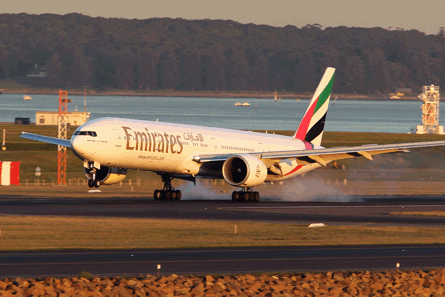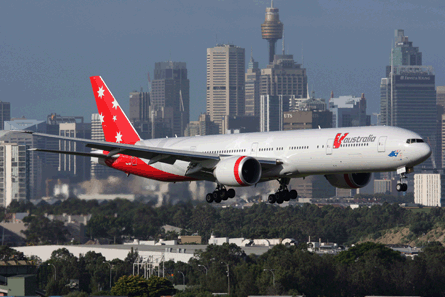A series of green demonstration flights recently completed in the Indian Ocean region has once again shown what is possible when air navigation service providers, airlines and airports work together to remove operational constraints.
The Indian Ocean Strategic Partnership to Reduce Emissions (Inspire) partnership achieved fuel savings of 13,482kg (29,723lb) and carbon dioxide savings of 42,469kg on five flights operated between Australia and the Middle East and South Africa.
Inspire was launched in November 2010 with the aim of developing gate-to-gate procedures, practices and services that have the potential to provide efficiencies in fuel and emissions reductions across all phases of flight.
 |
|---|
© Airservices Australia Emirates has worked with ANSPs on its flights to Australia |
Inspire follows Aspire - the Asia and Pacific Initiative to Reduce Emissions - which was established in February 2008 by Airservices Australia, Airways New Zealand and the US Federal Aviation Administration. It has since added the ANSPs of Japan, Singapore and Thailand to the team.
While Aspire focuses on the Asia-Pacific region, Inspire is aimed at implementing air traffic management (ATM) best practice in the Indian Ocean region and specifically air routes between the Arabian Gulf and Australia, southern Africa-Australia and South-East Asia and south-west Indian Ocean-Arabian Gulf.
Inspire involves nine ANSPs and four airlines. Service providers and airport authorities involved in the project include Airservices Australia, Abu Dhabi Airports Company, Abu Dhabi Department of Transport, Airport and Aviation Services Sri Lanka, Airports Authority of India, South Africa's ATNS, the Sultanate of Oman's Directorate General of Meteorology, Dubai Air Navigation Services, Dubai Airports, Maldives Airports Company and the United Arab Emirates' General Civil Aviation Authority.
 |
|---|
© Seth Jaworski/Airservices Australia The greatest fuel and emissions savings were achieved by Etihad on the Abu Dhabi-Sydney route |
The demonstration flights were conducted by four partner airlines - Emirates, Etihad Airways, South African Airways and Virgin Australia - with the flights operated under "perfect" ATM conditions. The plan is to follow these demonstrations with the development of a work programme designed to lead to the daily use of such best practices.
As in the Aspire flights, the aim of the Inspire demonstration flights was to show what flight efficiencies can be achieved within the current Arabian Sea and Indian Ocean ATM environment by removing controllable ATM system constraints as far as is practicable, according to Airservices Australia.
All of the flights benefited from unrestricted taxi and takeoff and an uninterrupted climb to the initial cruise level. In Australian airspace, the flights were permitted to operate on airline-preferred routes. On arrival, the flights had unrestricted descents directly to final approach and the shortest taxi routes to the gate.
FUEL SAVINGS
The demonstration flights kicked off on 10 March with a SAA Airbus A340 flight between Perth in western Australia and Johannesburg. The Perth-Johannesburg route is already highly optimised in the en route stage, with a number of ATM best practices in daily use, notes Airservices. Despite this, the flight still managed to achieve a fuel saving of 400kg - the equivalent of 10 tanks of fuel for an average size car - and 1,260kg of carbon dioxide emissions.
"The savings on this flight are notable because they highlight that improvements to practices in the departure and arrival phases of flight can make a notable reduction in emissions," says Airservices.
The demonstration programme took a break until July when a further four flights were conducted. On 16 July, Inspire demonstration flights were conducted by Etihad between Abu Dhabi and Sydney using an A340, and Emirates flying between Perth and Dubai and between Dubai and Brisbane using Boeing 777s. Virgin Australia ended the series with a 777 flight between Abu Dhabi and Sydney on 22 July.
The greatest fuel and emissions savings were achieved by Etihad on the Abu Dhabi-Sydney route, with a fuel saving of 4,800kg and carbon dioxide savings of 15,120kg.
This was followed by the Emirates Dubai-Brisbane flight with 3,508kg and Virgin Australia with 2,733kg. In total, the five flights achieved savings of 13,482kg in fuel and 42,469kg in carbon dioxide. In addition, the flights achieved time savings, with the Emirates flight to Brisbane, for example, shaving 51min off the normal flight time.
 |
|---|
© Seth Jaworski/Airservices Australia Virgin Australia ended the demonstration series with a flight between Abu Dhabi and Sydney |
The Arabian Sea and the Indian Ocean region is a "distinctly different air traffic environment" to Aspire's Asia-Pacific region, says Airservices. A focus of the Inspire demonstration flights was to reduce ATM constraints in the northwest region of the Indian Ocean. The Inspire demonstration flights also included an extension of the existing Australian Organised Track System (AUSOTS) programme, which has seen the implementation of flex tracks in Australian airspace. For the first time, the demonstration flights involved the use of two flex tracks at the same time between the United Arab Emirates and Sydney, with each flex track provided by the participating airline. "This is a significant evolutionary step in moving toward the target user preferred route environment," says Airservices.
Inspire chairman Ron Rigney, from the Abu Dhabi Department of Transport, said the programme demonstrated excellent co-operation by airport operators, ANSPs and airlines.
He points to, for example, efficient push-back procedures, as well as use of preferred taxiways and runways for departures and arrivals. In addition, Rigney says there was particularly close co-ordination between ANSPs to allow unrestricted climb and descent for the Inspire flights. Meanwhile, the relaxation of air traffic flow management restrictions by the Muscat ACC allowed preferential departure and unrestricted climb and descent for flights transiting UAE/Oman airspace. The timely and efficient delivery of ATM services by the Mumbai OCC, including the use of flex tracks, automatic dependent surveillance-contract/CPDLC messaging and the provision of direct routing, was also a positive outcome of the flights, according to Rigney.
Furthermore, where possible, direct routings and block level allocations for Inspire flights were used transiting the Male, Colombo and Melbourne and Brisbane flight information regions, while flex tracks were used across the southern Indian Ocean and company preferred flex tracks were used in Australian airspace.
Emirates says its participation in the programme is the latest example of its efforts to reduce emissions. Since 2003, Emirates says it has worked closely with ANSPs on its flights to Australia to reduce emissions, for example, to establish the use of flex tracks in the airspace of Africa, Asia and Australia. Over a five-year period, Emirates says the emission savings on its Australian flights equates to potential savings of 9.6 million litres (2.5USgal) of fuel and 24,268 tonnes of carbon dioxide emissions.
In 2011, based on an estimated 63 flights per week, approximate savings for the year will be around 2.47 million litres of fuel and 6,850 tonnes of carbon dioxide, says the airline. Captain Alan Stealey, divisional senior vice-president of flight operations at Emirates, says: "These flights illustrate that Emirates' long-term strategy to address environmental concerns has become a part of the everyday operating fabric of our organisation."
CREDIBLE TARGETS
No further demonstration flights are planned under the Inspire programme, according to Airservices, with the plan now to develop a work programme designed to allow these savings to become part of daily practice.
The emissions reductions demonstrated in the flights provide ANSPs with a credible target level to work towards, says Airservices. The next stage of the programme is due to be discussed at the next meeting of the Arabian Sea/Indian Ocean ATS Coordination Group in South Africa in November.
Inspire's sister programme Aspire has already reached the point of putting ATM best practice into daily use. Aspire involved six demonstration flights, operated by Air New Zealand, Qantas, United Airlines, Japan Airlines, Singapore Airlines and Thai Airways, between September 2008 and May this year.
The latest stage of the Aspire project saw the launch of daily city pairs in February. Aspire daily city pairs are those that operate under optimal flight plan conditions, deploying user preferred routes, dynamic airborne re-routing procedures, 30/30nm separation in the oceanic environment, time-based arrivals management, arrivals optimisation, departure optimisation and surface movement optimisation.
The demonstration flights, followed by data gathering and performance modelling, led to the efficiencies seen in the Aspire flights being repeated on a daily basis.
The first daily city pair was launched in February between Auckland and San Francisco, followed by Los Angeles-Singapore. The next route - Sydney-San Francisco - was due to be added in September, coinciding with the APEC environmental summit in San Francisco, along with Los Angeles-Melbourne.
Aspire daily city pairs are certificated with a star rating system based on the number of best practice procedures available. Airlines track and report usage of their nominated Aspire daily best practices through the International Air Transport Association, which has endorsed the programme as providing critical value for ANSPs and airlines.
Airservices says the Aspire partners plan to eventually have a network of "green routes" operating throughout the Asia-Pacific region, where the availability of ATM environmental best practice is monitored on a daily basis.
Source: Flight International
















